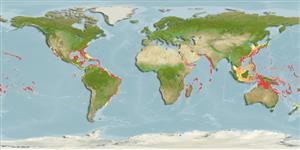Common names from other countries
Environment: milieu / climate zone / depth range / distribution range
Ecologie
; diepteverspreiding 0 - 115 m (Ref. 116112). Subtropical
Western Atlantic and Indo Pacific.
Length at first maturity / Size / Gewicht / Leeftijd
Maturity: Lm ? range ? - ? cm
Trunk circular in dorsal outline; lateral processes contiguous, without major tubercles. Ocular tubercle only as tall as wide; eyes large. Chelifore scapes I-segmented; chelae vestigial, globular. Palps 8-segmented; terminal 4 segments short, very setose. Ovigers 10-segmented, with weak strigilis bearing denticulate spines. Legs slender; first coxae with 2 and second coxae with 3 laterodistal tubercles. Cement gland tube at dorsodistal tip of femur. Propodus large, without major heel spines (Ref. 2115, p. 11).
Coastal (Ref. 19) and outer continental shelf (Ref. 116112). Epibiotic (Ref. 116112). On corals (Ref. 2086).
Life cycle and mating behavior
Geslachtsrijpheid | Voortplanting | Kuitschieten | Eieren | Fecundity | Larven
Members of the class Pycnogonida are gonochoric and sexually dimorphic. During copulation, male usually suspends itself beneath the female. Fertilization occurs as the eggs leave the female's ovigers. Males brood the egg masses until they hatch. Life cycle: Eggs hatch into protonymphon larva then to adults.
Stock, J.H. 1994. (Ref. 140)
Status op de Rode Lijst van het IUCN (Ref. 130435)
Status bij CITES (Ref. 108899)
Not Evaluated
Not Evaluated
Gebruik door de mens
| FishSource |
Tools
Meer informatie
Leeftijd/GrootteGroeiLengte-gewicht parametersLengte-lengte parametersMorfologieLarvenAbundantie
Internet-bronnen
Estimates based on models
Preferred temperature
(Ref.
115969): 22.7 - 28.2, mean 26.4 (based on 238 cells).
Prijsklasse
Unknown.
